Nearly 3 years ago, we received the first generation of the Yoga Book. Today we were lucky enough to receive the Lenovo Yoga Book C930.
Initially, the reviews of the first generation Yoga Book were very mixed, as people didn’t really know what to expect of this remarkable invention. And this is still the case today. You’ll mostly find it’s a love or hate relationship depending on which person you hand it to.
History
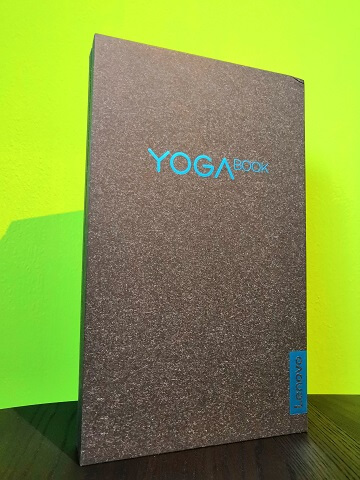 Apple released the first iPad Pro in 2015. It also came with a pen known as Apple Pencil. The accessory was chargeable through the Lightning port. In the years to come, Apple released two other generations that didn’t differ much from this one. To date, the iPad Pro is still using iOS, which is inferior to Windows in terms of what you can do with it. You’ll most likely end up buying a MacBook Pro to go with it, which can start costing a lot more down the road.
Apple released the first iPad Pro in 2015. It also came with a pen known as Apple Pencil. The accessory was chargeable through the Lightning port. In the years to come, Apple released two other generations that didn’t differ much from this one. To date, the iPad Pro is still using iOS, which is inferior to Windows in terms of what you can do with it. You’ll most likely end up buying a MacBook Pro to go with it, which can start costing a lot more down the road.
In 2016, Lenovo first released the ThinkPad P40 Yoga, which was the first Yoga in the ThinkPad line aimed at digital artists, engineers and architects. For whatever reason, Lenovo decided not to release another ThinkPad P40 Yoga but still continued with a Yoga in the S-series/L-series and the X-series ThinkPads.
Later that year, Lenovo released the first Lenovo Yoga Book, which is the predecessor of the Lenovo Yoga Book C930 we’re discussing in this review. The Yoga Book also has a 10” form factor, but the keyboard layout couldn’t be changed.
In the box, was a notepad, on which you could draw with a physical pen while the notepad was on top of the keyboard area. So the drawing would be mirrored on the screen and paper. We were fortunate enough to find the video below of Arthur Walker drawing on the first generation Yoga Book. You can read our review of the 1st gen model here.
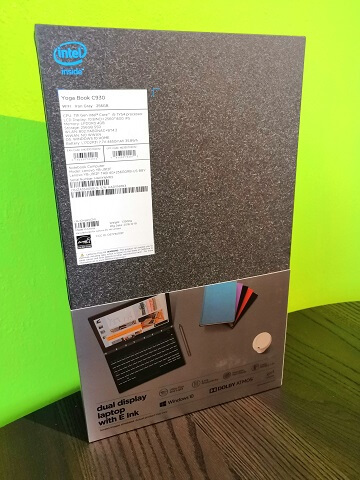 In 2018, Lenovo took the project one step further together with Intel. In a collaboration with Intel, they developed the successor. The name of Intel’s prototype alternative to the Yoga Book C930 is the ‘Intel Tiger Rapid’. The ‘Tiger Rapid’ went never into production, at least not that I can find.
In 2018, Lenovo took the project one step further together with Intel. In a collaboration with Intel, they developed the successor. The name of Intel’s prototype alternative to the Yoga Book C930 is the ‘Intel Tiger Rapid’. The ‘Tiger Rapid’ went never into production, at least not that I can find.
On the Lenovo Support website, you can download the SDK for the E-Ink if you’re interested. You’ll need to know C++.
Knock To Open
One of the most innovative features on the Yoga Book C930 is the ‘Knock To Open’. Do you know the saying ‘dress to impress’? You will definitely ‘knock to impress’ anyone you may encounter.
When the laptop is lying closed on a flat surface, knock twice. It will make a coil whine-like sound and open shortly after. If the lid is not opening, the knock interval is too short or too long, or the laptop could be upside down or too tilted.
The knock interval is hard-coded and cannot be changed in the BIOS or inside Windows.
Unboxing
Below you’ll find the unboxing video by Arthur Walker, a digital artist and writer who as owned every single Yoga Book.
Drawing & writing
We’ll skip the nerdy stuff below for now. You’re most likely interested anyways in what this thing can do. What makes it different? And more importantly, should you get one?
The Yoga Book C930 comes with a pen, you can use it to draw on the E-ink screen and on the display itself. It is paired by Bluetooth.
Pen

Inside the box is another box (pun intended) where you’ll find the pen with 3 buttons and one AAA-battery. This is a generic non-rechargeable battery you can find in any grocery store, online or supermarket.
The battery is installed by removing the end of the pen as indicated on the picture featuring the pen. You can simply pull the end to remove it. There is no need to twist it.
The battery is inserted with the anode (flat end or negative) towards the tip of the pen. The bumpy part or cathode is pointing towards the end. There are instructions inside the pen’s box to help you further. Either way, it’s hard to miss, because the anode would never be able to touch the metal part of the pen’s end.
When putting the end back, make sure the Lenovo logo is aligned with the 2 buttons as indicated on the picture. Otherwise the pen tip may not receive any power.
The pen has 4096 levels of pressure sensitivity on both the E-ink display and the primary display and uses Bluetooth to be paired.
Drawing and writing on the E-ink screen
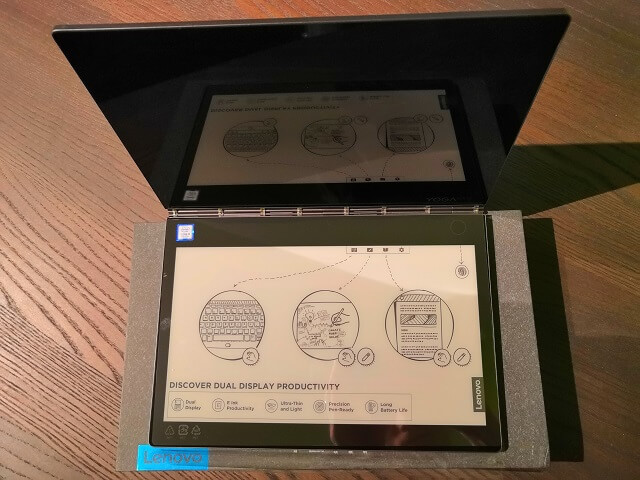
Drawing on the E-ink screen requires ‘Drawing Mode’ to be enabled, which you can easily do at the top right of the E-ink screen. You will draw on slides or pages and there is pressure sensitivity. You can create more of them as you go. The drawings are automatically saved.
You can copy the drawing by tapping the image-icon at the top of the E-ink screen. In Windows itself, you can copy the image where-ever you want. Whether it is Paint, Photoshop or Word. You name it.
Drawing on the E-ink screen is overall pleasant, however I preferred the primary display because it felt more responsive and integrates better with applications.
If you’re just taking some notes, the monochrome E-ink display is more than enough and can extend the battery life by lowering the primary display’s brightness while you’re taking notes.
Drawing and writing on the display
The primary display can also be used to draw or write on, but it does require applications that support it. Microsoft Office OneNote is probably a great and easy way to start as it comes pre-installed on the Yoga Book C930.
But to review this feature properly, let’s take some history lessons. The first convertibles Lenovo released with a pen were the ThinkPad Yoga and ThinkPad Helix. These convertibles used expensive digitizer display panels and digitizer pens on top of a touchscreen.
In those days, if you rested your palm on the touch display, it would recognize it all as touch input, even if you simply wanted to write or draw. It would only ignore the touch input if the digitizer pen was pointed at the display. But to do so, the digitizer pen needed to be pointing at the display at least in a 1 cm proximity.
You can understand that, when you’re resting your palm, and you move the pen tip away from the screen, it can get slightly annoying.
In the Yoga Book C930 however, it looks like your palm is being ignored entirely, even when the pen is not pointing at the screen. It looks like they finally have the palm detection optimized to right where it needs to be. Left-handed drawers and writers will no longer create a mess as they would on paper.
Keyboard & TouchPad
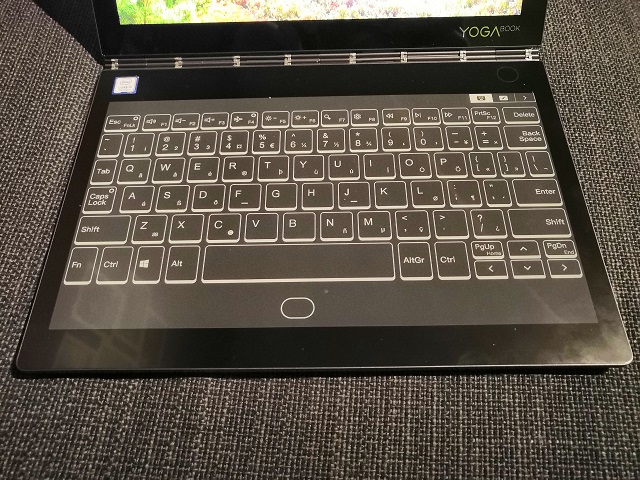
The keyboard is integrated in the E-ink display. You cannot control it with Windows, so there is a good chance it is compatible with Linux as well. You can change the keyboard layout by using the wrench icon on the e-ink display.
There is some haptic feedback to mimic a real keyboard, but the lack of key travel may still make it feel weird. It will take some training to get used to the keyboard. It’s adequate to get basic things done.
The first generation Yoga Book could not have its keyboard layout changed, not even if you wanted to have it replaced. The new Yoga Book C930 does allow a limited selection of the most popular keyboard layouts.
The keyboard layout for the E-ink screen is changed by using the wrench-icon at the top right. To change the layout of Windows’s virtual keyboard, you’ll have to open the ‘Settings’ application.
The virtual keyboard also doesn’t pop up automatically when you first start using your brand new convertible. To add the virtual keyboard icon on the task bar, right-click the task bar and make sure the option ‘Show touch keyboard button’ is checked.
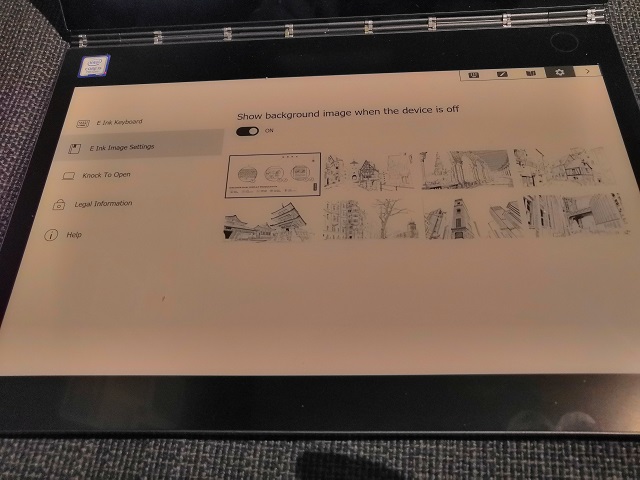 You can change the background image of the E-ink keyboard.
You can change the background image of the E-ink keyboard.
Performance
The first generation shipped with a quad core Intel Atom x5-Z8500 or x5-Z8550 processor. The performance wasn’t spectacular, but it was more than plenty where I was using the Yoga Book for. At least now, the Intel Atom processor is gone, and you can make use of the faster instruction sets from Intel Core processors. I will not go into specifics here.
So Lenovo decided to step up the game and go with an Intel Core i5-7Y54 for the highest configuration of the Yoga Book C930. This processor has a base clock of 1.2 GHz and a turbo clock of 3.2 GHz with a cache of 4 MB. It may be slightly slower than the Apple Bionic A12X.
Overall however, the Yoga Book does have the advantage of having a complete Windows operating system installed compared with Apple iOS.
You can’t expect the Intel Core i5-7Y54 to shatter all benchmarks and expectations. However, the Y-series processors from Intel have come a long way in terms of performance. When the Lenovo Yoga 3 Pro was released, the performance was slightly disappointing. I would not say that is still the case.
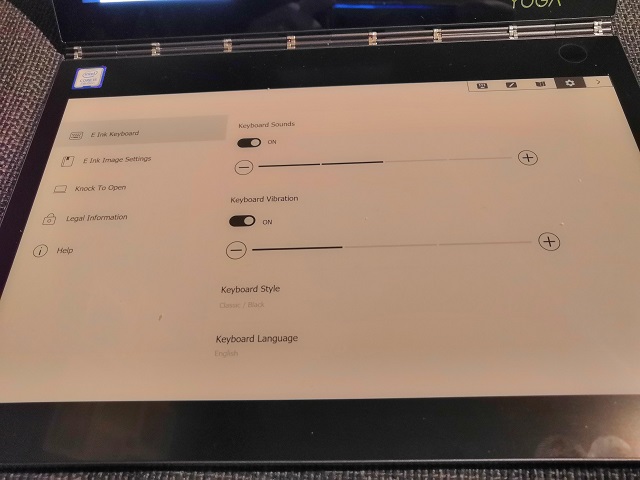 You have control over keyboard vibration, sound and limited selection of the most popular keyboard layouts.
You have control over keyboard vibration, sound and limited selection of the most popular keyboard layouts.
What you’re getting with the Intel Core i5-7Y54 is very stable battery life and adequate performance in a very thin form factor. For the audience the Yoga Book C930 was designed for, the performance is good.
Display
The first generation model had a display panel 1920x1200 - 400 nits - 70% color gamut display panel. The new Yoga Book C930 has a display panel 2560x1600 - 400 nits - 85% color gamut, and thereby slightly improves over the previous version. The iPad Pro achieves a maximum brightness of around 600-nits, leaving the Yoga Book C930 in the wind when it comes to outdoors productivity.
The display also does not use PWM. When dimming the display, you should not experience eye strain. While you won’t notice any flickering caused by PWM with the naked eye.
Battery Life & Charging
A battery capacity of 4650 mAh will last you around 10 hours, which is similar to the first generation model. Depending on how you use the device, it should be more than plenty.
The Yoga Book C930 ships with a USB-C charger with a 27W charger. You can expect the Yoga Book C930 to charge slowly while it is being used. It may be worth mentioning however, that the Yoga Book C930 is compatible with other USB-C chargers too.
I strongly recommend purchasing a 45 W or 65 W USB-C charger from Lenovo. During our testing, we managed to achieve a peak power consumption of around 42 Wh while we were using the device on a 90% battery capacity. We were unable to take the power draw any higher while the device was being stress tested.
If you can shell out an extra 20-60 USD, you can accelerate the pace at which your Yoga Book C930 charges by as much as 50%. I would recommend to avoid third-party USB-C cables and chargers as this could lead to mixed results.
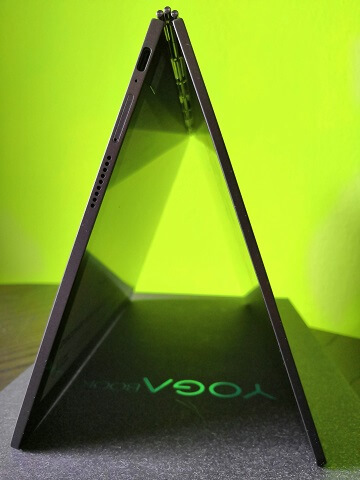 Left side showing the card slot and USB-C port.
Left side showing the card slot and USB-C port.
Connectivity
On the left side, we find a USB-C port and a card slot.
The card slot allows installation of either 1 nano-SIM card or 1 micro-SD card with up to 512 GB of storage for the WWAN model. On the Wi-Fi model, you will have only 1 micro-SD card slot available.
On the other side, we find the other USB-C port, making two USB-C ports in total. On the right side, you’ll also find the power button and volume buttons.
You can recognize the power button by it’s textured surface and shorter appearance. The volume buttons have an even surface and are longer. The design of the buttons look similar to those found on Motorola phones.
Benchmarks
In Passmark PerformanceTest 9.0, the Yoga Book C930 made it into the 51st percentile with a PassMark rating score of 2282.
When we’re looking at just processor and graphics performance, we’re in the 35th and 40th percentile. This was to be expected as the processor with the integrated graphics is the weaker component in the Yoga Book C930.
However, we’re seeing a significant improvement for the ‘Disk Mark’ score. This is most likely due to the fact of the significant recent improvements made with the introduction of NVMe.
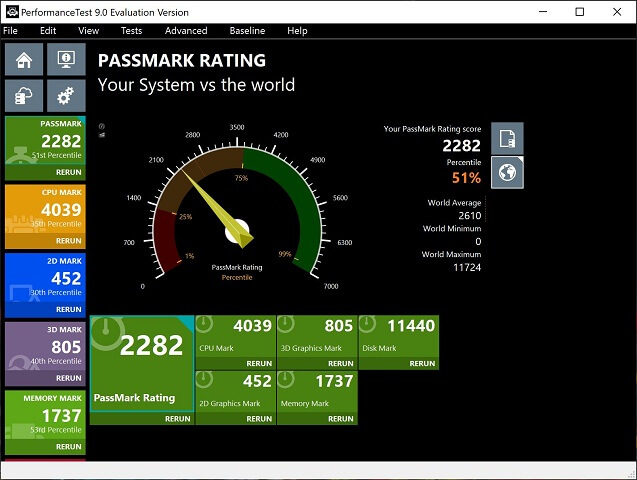 PassMark Performance Test 9.0 on Yoga Book C930
PassMark Performance Test 9.0 on Yoga Book C930
In Cinebench R15 by Maxon, we’ve managed to get an OpenGL score of 35.05 fps and CPU core of 228cb.

What’s next for the Yoga Book?
Lenovo invested in CLEARink and the two companies have started to develop the next generation of the Yoga Book. Lenovo has also joined CLEARink’s board of directors.
Troubleshooting
For any questions or problems you may have, make sure to turn to the Lenovo Forums or check the Knowledge Database for solutions.
Linux
The Yoga Book C930 is currently not compatible with Linux.
3 months later
Generally, if I have a ThinkPad lying around, I feel less likely to pick up my Yoga Book C930, but when I travelled to Philippines for a 2 week vacation. I left all my traditional laptops at home. And decided to do some blogging. I wrote a couple of articles with more than 750 words in length.
After a few days, I was able to blindly type nearly as well as on my ThinkPad P51s. I actually found the most annoying part about the Yoga Book C930 to be the touchpad, I don’t like to tap the ‘circle’ on the keyboard to expand the touchpad. Overall the keyboard itself is fine. But you may want to bring a Bluetooth mouse or a traditional mouse with a USB-C adapter.